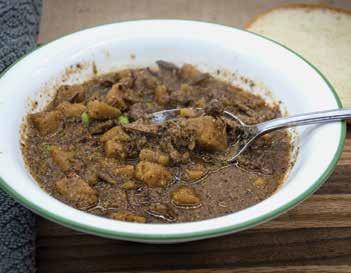
25 minute read
OPINIONS
When You Get There, Remember Where You Came From A Message from WFBF President Joe Bragger
I’ve been asked many times since December about my decision to run for Wisconsin Farm Bureau President. First and foremost, it’s a humbling experience to be in this role serving our more that 47,000 members across the state. Like a true farmer, I can’t wait to get to work. Just like farming, there are constant seasons at Farm Bureau, and we are already well underway in 2020. I’ve had the chance to introduce myself to many people in the past weeks, but I wanted to talk to you about what I aim to achieve most as your new president.
Advertisement
Taking challenges head on.
It is my strong desire to transcend division while taking the issues head on. This seems to be somewhat of a contrasting statement, so let me explain. Like you, I see the division in our political world and anxiously want to bring people together on nonpartisan items like agriculture. The issues from a political standpoint can be very divisive at times. Having a strong debate, doing the research and hard work, allowing for some compromise and ultimately just doing what is right for farmers and our rural communities will never go out of style and we will work as an organization to encourage those healthy discussions to limit the disagreement among farmers.
I know the disconnect between farmers and consumers is holding us back. As the largest general farm organization, we must be engaged in ways to decrease the divide. Giving our members the power through leadership development programs puts us on the right track.
Someone once explained to me that in the West there are cattle and buffalo on the same hills. When a storm rolls in, the cattle become restless and start to stir while the buffalo turn to face the storm. With their heads down resolute, they head straight into the storm while the cattle run. The cattle are in the storm much longer as they are constantly trying to run from it. However, the buffalo only experience a short time in the storm as they charge through it onto greener grass. I wish for us as Farm Bureau members to be the buffalo and take on the storms.
Work together to determine our future and continuously improve.
I strongly believe our largest strength as an organization is our grassroots policy development process. WFBF’s policy is established by farmers through a structured policy development process. Suggestions and policy ideas come directly from members who propose and vote on them at county Farm Bureau annual meetings. Policy ideas work their way up to the Wisconsin Farm Bureau Annual Meeting each December where delegate members vote on the proposals. This process continues at the national level.
While WFBF’s Board oversees how that policy is directed and the overall direction of Farm Bureau, no single person or segment controls the organization. From the bottom to the top, our vision is directed by everyone.
Certainly, I have some ideas to help increase our ability to not only support our members but to further their ability to help themselves, but I was given a word limit for this column. Good, bad or indifferent, everyone has something to offer and it’s my goal to grow our talents and use them to push us into the next century.
As a farmer, I’m never satisfied. Sure, you can have a good year, but you can always do better, right?
We just celebrated 100 years. How will we achieve great things in the next 100 years? By constantly improving and trying to do better than last time.
The key to our success will be doing what we do best: uniting farmers and agriculturists and working together. The title of this column came from a sign that now sits in my office in Madison. To me it signifies the pride I have of serving as your president. I hope to protect you, defend you and stand beside you in every way possible. I’m here, but I won’t forget where I came from. Hold me to it.
Bragger was elected president of Wisconsin Farm Bureau in 2019. Bragger is a dairy and poultry farmer from Independence.

A Promising Harvest for Ag Trade A Message from AFBF Vice President Scott VanderWal
America’s farmers and ranchers are eager to turn over a new leaf on the trade front. From the signing of the United States-Mexico-Canada Agreement to the groundbreaking Phase One trade deal with China to the U.S.-Japan Trade Agreement, the Administration is answering the call to expand trade opportunities for U.S. agriculture. And there’s no question that we are eager to get back to business in the global marketplace.
Of course, farmers and ranchers will need to see results before they celebrate. But those results will happen only if we negotiate and sign trade deals to pave the way for increased trade.
The trade war has taken its toll on our farm and ranch land and rural communities, and restoration of our markets cannot come soon enough. While we all pray for Mother Nature to be kinder this year, farmers and ranchers across the country are ready not only to return to full steam in production, but also begin to explore opportunities for meeting the demand of expanding markets.
With the USMCA ratified by the U.S. and Mexico, we have only to wait for the Canadian parliament to approve the deal as well before it can go into full effect. It’s no secret that the idea of reopening NAFTA gave us some heartburn in the ag community, but we have come out on the other side with a stronger, modern agreement that has created a framework for other ag trade deals. Those improvements didn’t happen by accident, either: this deal is testament to our strong grassroots efforts working across the ag community and with Congress and the Administration. And while it may not be perfect, we came out with a deal that not only protected agriculture’s gains from NAFTA but also will increase our ag exports to Canada and Mexico by $2 billion.
The Phase One deal with China promises even greater returns, more than double what China’s ag purchases were before the trade war. This is a tall order—and far better than we could have hoped for when this trade war began nearly two years ago. When President Trump came to our annual convention in Austin, he expressed his confidence in America’s farmers and ranchers to meet the increased demand of an anticipated $80 billion in ag purchases from China over the next two years. I think we can all agree that we are more than up to that challenge. A question we’ve been asked is whether these amazing increases in agricultural exports to China are realistic. Will they actually happen? We are heartened by the Administration’s assurance their work isn’t done: the deal will be monitored to ensure that China lives up to its commitments.
Although we have passed some significant mile markers, the race to expand U.S. agriculture’s global market share is far from over. We are urging the Administration to build on this momentum and complete a full trade agreement with China to secure fair and free trade there once and for all. We also will be keeping a close watch on progress with EU trade talks to bring balance to ag trade and remove the continent’s nonscientific barriers to our ag products, and we anticipate the upcoming talks with the UK can expand an already strong market for our farm exports.
The remaining hurdles are real, and it will take time to rebuild our markets once these new deals go into effect. But the accomplishments we are celebrating this month are proof that these challenges can be overcome. Time and again, America’s farmers and ranchers have risen to the challenge of competing in new markets. Our ag exports have traditionally enjoyed a surplus, not by chance, but because of the sterling reputation of Americangrown food, fuel and fiber. Thanks to these new trade deals, we can continue to lead the way in growing the highest quality, and most sustainable, ag products in the world.

VanderWal is a third-generation corn and soybean farmer and cattle feeder from Volga, South Dakota. He is president of the South Dakota Farm Bureau and vice president of the American Farm Bureau.

We All Do It A Message from WFBF's Amy Eckelberg
It was Theodore Roosevelt who said, “Do what you can, with what you have, where you are.”
I’ve always had this quote bookmarked, but as a new mom I seem to relate to it even more. Some days, you just have to get thrifty. You need to use the things that are handy at the time to accomplish tasks, whether it’s your life as a whole or a broken fence or piece of machinery. Last fall, I had an epiphany while on maternity leave. As I was holding our daughter, I wanted some information so I did what most people do. I Googled it. I felt guilty. As I sat there with Google up on my phone and a sleeping baby in my arms, I realized that I have been telling others not to Google things,

just like I was doing.
I’m sure my doctor, a highly trained professional with years of schooling and experience, would have been severely disappointed with my decision. While my baby had a very small bottle blister, I was convinced by my ‘Google expert’ that it was much worse.
Now, to relate it back to my aggie friends. I’ve pleaded my case numerous times. “Don’t Google; talk to a farmer.” I bet you have, too.
I have explained to many audiences, including moms, why you shouldn’t Google information on farming and food, but rather talk to a farmer. How convenient is that? How realistic is that? According to Internet Live Stats, which I found through Google, the search engine now processes more than 40,000 search queries every second on average, which translates to more than 3.5 billion searches per day and 1.2 trillion searches per year worldwide.
What is the chance that someone is going to not Google food information because I told them not to? Not very likely.
We are a society that likes things quickly. So whatever information we want consumers to digest, they better be able to get it fast and easy.
As a society, we Google things. EVERY. THING.
Remember the old phrase, if you can’t beat them, join them? I think it’s time that we join them.
My plea to you is this – what are we serving our peers who want information about food and farming. Are you doing your part to show up in a Google search? Have you Googled topics that are of interest to you and your farm? What comes up?
Try looking at ‘Google Trends’ to dig into different search terms trending over time in our area. What terms on food and farming are popular in your area?
We do have some farmers who do a great job of getting on the World Wide Web, but nowhere near enough. Are you doing your part? Are you posting stories and photos from your life in agriculture on social media? Are you actively blogging? Have you ever Googled your farm’s name to see what comes up?
It’s important to join the conversation online. That could make you overwhelmed though.
My best advice? Just “do what you can, with what you have.”
Know that you don’t have to do it all. But do something online because every bit helps, and you don’t know who might be reading it and learning from you - the expert.
Eckelberg is WFBF's Executive Director of Public Relations.

Public Attitudes about Farmers and Farming: A Golden Opportunity A Message from AFBF's Terri Moore
Farmers enjoy one of the highest levels of public trust of any group or potential source of information, ranging from scientists to government experts, and certainly more than leaders in the retail sector. While the levels and rankings vary among surveys, the level of trust in farmers comes shining through in all of them. This reality was reinforced by our own recent survey at American Farm Bureau, which found that 88 percent of Americans trust farmers. Undoubtedly the envy of politicians. Kidding aside, this presents an incredible opportunity.
The nuance often missed is that public trust of farmers doesn’t always convey to farming. Our recent research shows only one person in five has a high level of trust in modern agriculture and about half the population trusts modern ag somewhat, which means they are skeptical. While it’s true that the term 'modern agriculture' means different things to different people, we can look across multiple consumer research projects and see similar results: a big gap between the level of trust in farmers versus farming.
Why the trust gap and what can we do about it? There are multiple reasons. The public is uncertain what to think of the advancements in agriculture, including the use of technology in crop protection and plant/animal breeding. The growing size of farms doesn’t fit the nostalgic image of a lone red barn. Public uncertainty is reinforced by consumer advocates who question whether advancements are in the best interest of a safe and sustainable food supply, and by activists whose mission is to undermine agriculture.
So, what do we do about it? We need some of the most trusted folks on the planet, farmers and ranchers, to step up engagement with the public about all the ways modern agriculture actually aligns very closely with their values. If we explain how we’re achieving remarkable advances in sustainability and animal care, we will build trust in farming. The great news is that we know the skeptical public is interested. Our survey shows three out of four Americans want to know more about how their food is produced. Their hunger to learn more presents an enormous opportunity.
Inviting the public to see and hear about the benefits of modern agriculture can literally take hundreds of forms. Farm tours, op-eds, classroom visits, social media posts, grocery store conversations, city council meetings and on and on. The key is to engage without first judging. It’s difficult. As people who have cared for the land and livestock 24/7 with a level of dedication unmatched in many other professions, it is frustrating to hear people express mistrust of agriculture. That said, if we start by criticizing their views, we close the door to building trust. Case in point: How many times have you been won over by someone with a different view who starts by criticizing your views? Exactly.
If we fail to distinguish irrational activists (whose existence evolves around criticizing agriculture) from rational skeptics (who are genuinely trying to decipher what is right), we risk alienating the 49 percent of Americans who trust agriculture only somewhat. Combined

with the 12 percent who say they aren’t sure, more than 60 percent of Americans fall within the proverbial moveable middle. They are the open-minded, waiting to be engaged by someone they trust.
Bottom line: farmers are highly trusted to tell the story of agriculture and explain how production practices align with societal values. The opportunity is clear. The public is interested. An array of Farm Bureau resources are available to help with effective engagement. If you are among the farmers stepping up, I commend you. You are helping to ensure we don’t further cede to activists the opportunity to tell agriculture’s story. We need more farmers to share how we are working to deliver safe, high-quality food, fiber and fuel around the world. Don’t know where to start? Call us.

Moore is vice president of communications at the American Farm Bureau Federation.
Diversification Key for Profitable Grain Marketing A Guest Column by AgriVisor's Joe Camp
Diversification has long been a buzzword of financial markets, used often to express the benefits that result from allocating capital toward a large and varied pool of investments. It also is a term used often by good agricultural risk managers wishing to encourage producers to employ the practice within their grain marketing plans.
With diversification comes a basic rule: having more options is better. Diversification mitigates risks that are otherwise present when financial returns depend on a limited scope of investment options, which fits with the saying, “don’t put all your eggs in one basket.”
Diversification on the farm can entail everything from the types of crops grown to the contracts used to make crop sales. The Sustainable Agriculture Research and Education organization recognizes diversification of crop plantings as a means by which environmental benefits and economic profits can be enhanced due to the spreading out of weather and rotational stress risks.
Hemp is the latest example of a new crop that is being added to rotations in an effort by farmers to diversify their production and marketing options. The inclusion of a crop like hemp comes with added risks of its own; however, it still may produce a net financial benefit when considering the reduction of risks related to operating a one- or two-crop rotation plan.
Focusing on diversification of crop sales, a related saying that I use often is, “look for base hits over homeruns.” Studies have shown that the best farm marketers on average make more than eight to 10 sales throughout the marketing year. Looking for those singles and doubles instead of swinging for the fence at the risk of striking out, smaller sales allow you to tolerate a greater

margin of error on decisions made at an unfavorable time or price.
We encourage producers to not only make smaller sales but to also make sales using many different contracting options. Getting to know your available marketing alternatives is a key first step in the effort to practice diversification.
Spot or forward cash sales are the primary methods by which grain is marketed during a typical crop year, but they might not always be the right course of action. Cash or forward sales work well if the expectation is for both futures to fall and basis weaken. Become informed on the various types of contracting offered by your local buyer, so that alternative action can be taken when higher futures or better basis is in your outlook and storing is not the preferred option.
Diversification, when used as a strategy to expand options available to farmers, is one of the most crucial foundations of a successful marketing plan. Examine your current production and marketing practices to determine if further diversification may benefit your farm.
Camp is the risk management specialist for AgriVisor, one of WFBF's member benefits.


What to Watch for in 2020 A Message from AFBF's Cole Staudt T he start of a new decade holds a lot of promise for American farmers and ranchers. Much-anticipated progress in hemp regulation, sustainability, technology and a presidential election will be key items to watch for this year. While 2019 was challenging overall for agriculture, the last few weeks of the year featured promising developments likely to carry over into the new year. Over the past few years, significant disruptions in key export markets have hit farmers and ranchers hard. Recently completed trade agreements with some of our largest agriculture export markets— Canada, Mexico, Japan and China— should help provide some certainty. Market Facilitation Program payments have been a lifeline for many farmers who have been impacted by ongoing trade disputes and we should expect a third round of payments in 2020.
There are still significant hurdles to growing, transporting and processing hemp as farmers navigate complex, and sometimes unclear, state and federal regulations. For the 2020 growing season, farmers have the certainty of the Interim Final Rule from the Agriculture Department, which provides the clarity needed to grow, harvest and test their hemp crop. Last year, USDA extended Whole Farm Revenue Protection coverage to hemp growers for the 2020 crop and announced a pilot insurance program that will provide coverage for some farmers.
Hemp growers are looking for significant progress in gaining easier access to financing and transportation for their crops. New rules for those issues and THC content testing are needed to help this industry grow nationwide.
As the discussion around how best to care for our environment rages on in Washington and among 2020 presidential candidates, farmers and ranchers are taking more steps to improve soil health, reduce runoff and conserve energy. Farms and ranches are passed down from generation to generation and as caretakers of the land, farmers want to employ cost-effective solutions to ensure soil remains productive. In 2017, acres using conventional tillage were down 24 percent, while acres using conservation tillage and no-till were up 28 percent and 8 percent, respectively, a trend we can expect to continue in 2020.
Increased use of buffer strips, cover crops and nutrient management plans are becoming more common as precision agriculture technology is developed and deployed. This technology will allow farmers and ranchers to precisely identify where to apply fertilizers and necessary pesticides and to develop strategies to protect against soil erosion and runoff. The implementation of precision agriculture technology will continue in 2020 as broadband access is brought to more communities. The 2018 farm bill created the Federal Communications Commission’s Task Force for Reviewing the Connectivity and Technology Needs of Precision Agriculture, which recently held its first meeting. The task force will work with USDA this year to develop policy recommendations to ensure reliable broadband on 95 percent of agricultural land by 2025.
This year is a presidential election year, which everyone in rural America will follow closely. Many of the swing states have significant rural populations that rely on agriculture and we have already seen most Democratic presidential candidates vying to be their party’s nominee roll out plans to invest in rural communities. Expect to see President Trump and the eventual Democratic nominee court voters in rural communities with plans on broadband, farm subsidies, small businesses and health care.
While all these issues are important to farmers and ranchers, likely the most important factor for agriculture this year is one we can’t predict: the weather.

Staudt is the media relations specialist at the American Farm Bureau Federation.
Up the Creek A column by Ken M. Blomberg
Our flock of mourning doves numbers 40-something this winter. They come and go from our feeders throughout the day. They roost in our pines across the road at night. They share sunflower and mixed seeds with the likes of juncos, jays, chickadees and cardinals.
Artificial feeding of birds in the winter has a storied history. Naturalist James Fisher named sixth-century monk Saint Serf of Fife as the first person feeding a wild bird – a pigeon he ultimately tamed. The United Kingdom declared feeding birds a national pastime in 1910. In 1932, famed conservationist Aldo Leopold wrote a regular column in the publication, Wisconsin Agriculturist and Farmer. In December of that year, he discussed feeding songbirds. “Would you like to sit at your south window and watch cardinals, chickadees, nuthatches, juncos, tree sparrows, blue jays and woodpeckers eat breakfast? It is easily arranged.” He set forth three easy steps for attracting birds to your feeding station. First, tack a piece of suet to a nearby tree. Second, erect a feeding tray. Finally, place nearby evergreens, vines or thick bushes. “A good feeding station is the best of classrooms for learning ornithology ... you will enjoy it quite as much as the birds.”
Feeding game birds in winter is another story. In 1949, Wallace Byron Grange, the first superintendent of game for the Wisconsin Conservation Commission and original owner of the Sandhill Wildlife Management Area, called winter feeding of game birds no substitute for naturally produced foods. “In a way, it is the difference between a breadline and a satisfactory job,” he quipped. “Nevertheless,” he continued, “winter feeding does have its place and may be a meritorious endeavor … and during climatic emergencies may be the one means of bringing upland game birds through the winter.”
Aldo Leopold, in his classic 1933 book, “Game Management,” described four winter game bird feeding methods. They included food patches, self-feeding stations, feeding stations and emergency feeding, which all requiring different levels of effort on the part of the birds and landowners. Today’s conventional wildlife management wisdom frowns on supplemental feeding of game birds and other wild animals. Wisconsin’s DNR notes that wildlife adapt physiologically and behaviorally to survive the rigors of winters, being less active and feeding less and relying on body fat reserves. If done wrong, winter feeding can do more harm than good. Therefore, they say, “Do it right, or don’t do it at all.”
In fact, in many counties across the state, deer feeding and baiting is prohibited. Interestingly, feeding game and song birds also is prohibited, but only if deer can access feed set out. Back in 2003, Wisconsin Act 240 extended DNR’s authority to regulate the feeding of wildlife for non-hunting purposes, required that the DNR ban baiting and feeding deer in counties at highest risk for disease transmission like chronic wasting disease and established standards for the baiting and feeding of deer outside these banned areas.

Years ago, before the ban, we maintained a Pheasant Forever feeding station in the prairie field east of our house. From our kitchen window, we delighted in viewing a steady stream of wildlife including turkey, deer, quail and pheasants using the corn and grain we’d put in the feeder. Since the feeding ban, we only maintain our backyard bird feeder. Last year, a few deer ventured from across the road a couple of nights in late winter and left tracks under our feeders. This year, there are no tracks in the snow. So, I think we’re OK.
But are my mourning doves putting me at risk of violating the ban when they pick up spilled sunflowers on the ground under our bird feeders? No, say officials, “If material is placed solely for the purpose of attracting and feeding wild birds and small mammals, and is placed in bird feeding devices and structures at a sufficient height or design to prevent access by deer, and the structures and devices are within 50 yards of a dwelling devoted to human occupancy. When deer, bear or elk are found to be utilizing bird feeding devices or structures, the devices or structures shall be enclosed or elevated higher to prevent access by deer.”
Mourning doves are game birds. So are quail, pheasant and turkey. They are prone to visiting our feeders and picking up what spills on the ground. As long as the deer stay away, am I in compliance? And is it possible to construct a game bird feeder farther than 50 yards from our dwelling that is enclosed and inaccessible to deer? I guess it’s time to contact the area warden, or my cousin Kathy. She’s a lawyer.
Blomberg is a freelance writer and a member of the Portage County Farm Bureau. His books, "Up the Creek" and "Wisconsin Bird Hunting Tales and Letters from Art" are available at amazon.com.



Old Fashioned Beef Stew Ingredients • 4 Tbsp. vegetable oil • 1/2 c. flour • 1 tsp. garlic powder • 1 tsp. salt • 1 tsp. pepper • 6 large potatoes • 1-2 lb. stew meat, chuck roast (cubed) or round steak (cubed) • 1/2 c. onions, chopped • 1 can peas • 3 10.5 oz. cans beef broth Directions 1. Heat oil in skillet. 2. In plastic bag, mix flour, garlic powder, salt and pepper. Add a few pieces of meat at a time, shake until well coated. 3. Add onions and meat to oil. Brown until no longer pink. 4. Add all ingredients to crock pot and cook on low for several hours. 5. Just before serving, add a flour/ water mixture to thicken stew. 6. Serve with warm bread or buns. Cranberry Coffee Bread Ingredients • 1/2 c. butter or margarine • 1 c. sugar • 2 eggs • 1 tsp. almond extract • 2 c. flour • 1 tsp. baking powder • 1 tsp. baking soda • 1/2 tsp. salt • 3/4 c. plain yogurt or sour cream • 1/2 c. walnuts, chopped (optional) • 1 c. whole berry cranberry sauce Directions 1. Preheat oven 350°. Butter bundt pan and dust with flour. 2. In large bowl, cream butter or margarine and sugar. Beat in eggs and extract. 3. In second bowl, mix flour, baking soda, baking powder and salt. 4. Add flour mixture to egg mixture 5. Stir in yogurt or sour cream. Add nuts. 6. Spread half of batter in pan. Spoon half cranberry sauce on top. 7. Cover with remaining batter and rest of cranberry sauce. 8. Bake on middle oven rack for 50 minutes or until toothpick comes out clean. Submitted by Rebecca Poppy Submitted by Dale Behrend
Triple Layer Chocolate Peanut Butter Brownies Submitted by Katrina Gleason
Ingredients • 1 brownie mix, prepared in 9x13 pan • 1 c. milk • 1 3.4 oz. package vanilla pudding • 1 c. creamy peanut butter Directions 1. Whisk milk and pudding. Add peanut butter and powdered sugar; mix well. 2. Cover and refrigerate until brownies are completely cooled. 3. Spread mix over brownies. 4. Microwave whipped topping and • 1/2 c. powdered sugar • 11/2 c. cool whip (do not thaw) • 3 squares or 3 Tbsp. semi-sweet chocolate
chocolate on high 1 minute. Stir every 30 seconds. (Once it is heated through, continue to stir until it comes together.) 5. Pour over pudding layer. 6. Refrigerate 1 hour before serving. Refrigerate leftovers.










